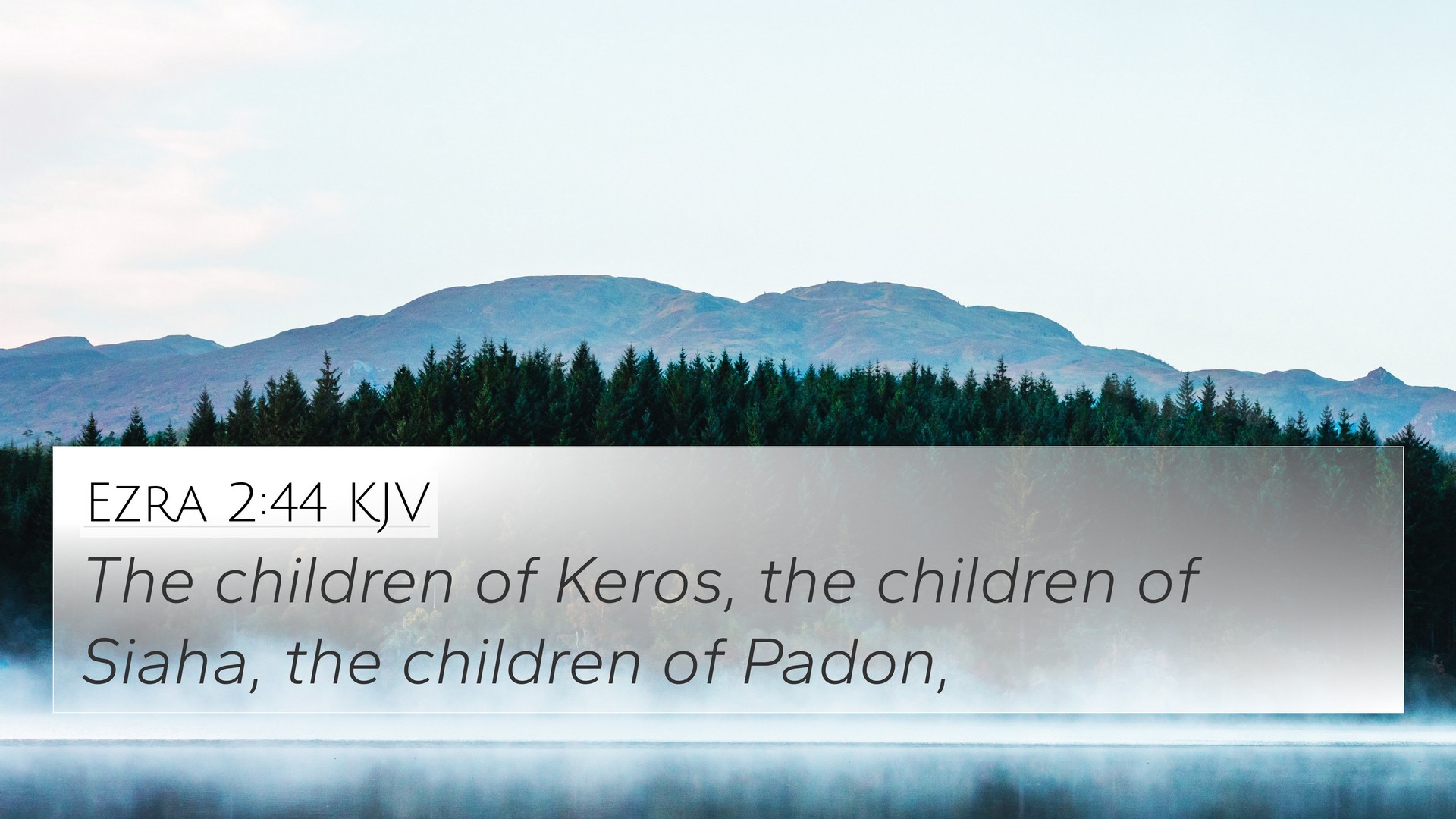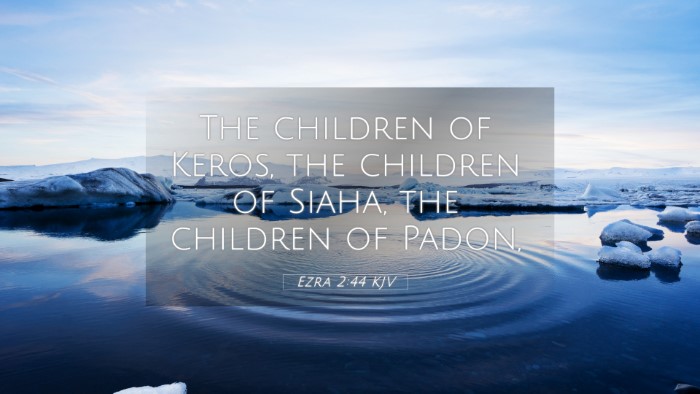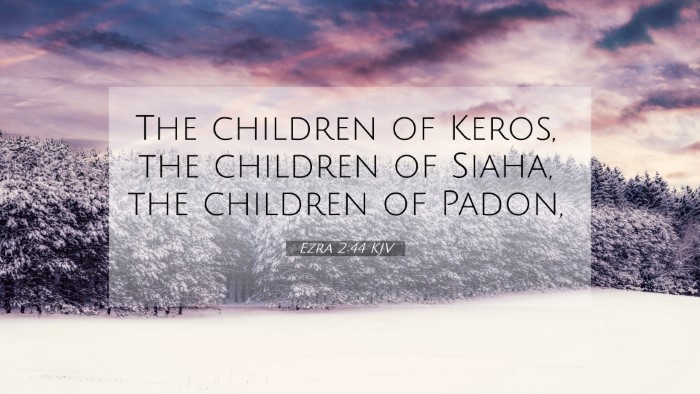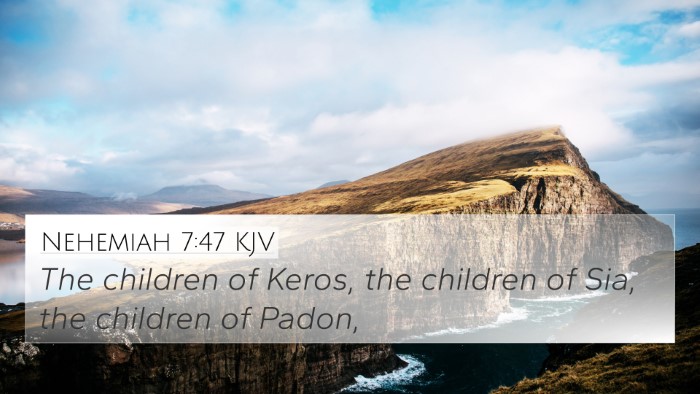Summary and Interpretation of Ezra 2:44
Verse Context: The Book of Ezra recounts the return of the exiles from Babylon to Jerusalem and their efforts to rebuild the Temple. Ezra 2:44 specifically lists the servants of Solomon who returned, thus emphasizing the continuity of service and worship despite the upheaval of the exile.
Understanding Ezra 2:44
This verse states: "The children of Solomon's servants: the children of Sotai, the children of Sophereth, the children of Peruda." In examining this verse, we find that it encapsulates the return of individuals categorized as the servants of Solomon, which denotes a historical tie to the glory of Solomon's reign and the service rendered in the Temple.
Interpretative Insights:
- Historical Significance: The mention of Solomon's servants reflects the long-standing tradition of service within the Temple framework. It serves as a reminder that God's people are called to serve Him according to the lineage and duties established in previous generations.
- Continuity of Worship: The return of Solomon's servants signifies God's faithfulness in maintaining a worship community. Matthew Henry notes that despite the exile, God preserves a remnant dedicated to His service, echoing His covenantal promises.
- Restoration Theme: Adam Clarke emphasizes the theme of restoration throughout Ezra. This verse illustrates the beginning of restoration, connecting past glory to present actions, suggesting that the restoration of worship and community is a divine priority.
- Identity and Community: This verse showcases the identities of those returning to Jerusalem. Albert Barnes remarks on the importance of communal identity; these individuals are linked not just to their ancestors but to the very purpose of their return—a mission of rebuilding and serving.
Cross-References to Ezra 2:44:
- 1 Kings 9:22: Discusses Solomon's appointed servants and their roles.
- Ezra 2:55: Mentions the servants of Solomon in broader context, showing their significance in the returning group.
- Nehemiah 7:57: A parallel listing of the servants and their heritage.
- 2 Chronicles 8:8: Refers to the servants whom Solomon appointed for various tasks, linking them to his building projects.
- Psalm 26:8: Reflects the love for the dwelling place of the Lord, echoing the sentiments of those returning to service.
- Ezra 3:8: The initial rebuilding of the Temple begins in the second month after their arrival, indicating the urgency of worship.
- Isaiah 44:28: Prophecies concerning the restoration of Israel, emphasizing God's plan for His people.
- Jeremiah 29:10-11: Promises of hope regarding the return from exile, providing context for the motivations behind the returnees’ actions.
- Zechariah 8:7-8: The gathering of God's people, illustrating His desire for unity and worship.
- Acts 15:16-17: New Testament connections to the regathering of people as part of God’s redemptive plan.
Connections and Themes:
This verse emphasizes several key themes relevant to both the Old and New Testaments:
- Divine Preservation: The concept that God preserves a people for Himself despite adversity, seen throughout Scriptures.
- Identity in Community: The importance of being part of a communal faith journey resonates through both Testaments.
- Continuity of God’s Plan: The link between Solomon's time and the post-exilic restoration illustrates the ongoing narrative of God's faithful dealings with His people.
- The Role of Servanthood: Highlighting the dignity of serving God and His house—a theme prevalent in the teachings of Jesus regarding service.
Conclusion: Ezra 2:44 serves as a reminder of the importance of continuity in serving God across generations. As this verse captures the essence of those returning to Jerusalem, it encourages believers to recognize their identity in the history of worship and service to God. The connections made in cross-referencing other Biblical texts enhance our understanding of God's overarching plan of redemption and involvement in human history.
These insights enable a richer study of Scripture, encouraging readers to engage in cross-referencing Bible studies and explore the thematic connections woven throughout the Word of God. For anyone interested in Bible verse cross-references or finding how different Bible verses relate to each other, this analysis provides foundational context and connections that deepen one's understanding of the Scriptures and God's enduring nature.



